Abstrakt
The term ‘flea market’, which we have now replaced with the more neutral ‘antique market’, has been known in Europe since at least the end of the 17th century. Its meaning and function have evolved over the centuries. Initially, the things gathered there were intended for the poorest people, who were able to buy the basic items they needed for daily living there cheaply. From the mid-19th century, flea markets became the focus of interest for collectors. Today, they fulfil a slightly different role. This is linked to a change in attitude to ‘old’, worn-out, broken and unfunctional things, to ‘junk’. This is sometimes associated with an environmentally friendly attitude. It is becoming fashionable to give objects a second life by transforming them, giving them a different meaning and function, sometimes creating original works of art through them, but this is not the only expression of a change in attitude towards discarded objects. The public visiting antique fairs is looking for unique, but imperfect, often worn-out objects with traces of use among the “rubbish,” which most often comes from the flats being emptied. Once introduced into the everyday surroundings of their new owners, they will contradict the unified world of objects that constitute the iconosphere of modern life. It cannot be ruled out that the interest in what until recently was considered something of rubbish dump is connected to the changes in everyday life, the acceleration of everyday existence that we have all experienced in recent years. Times of exceptionally rapid globalisation, the expansion of electronic media, which have revolutionised communication between people, often stripping it of personal contact, may translate into an attitude towards these “junk” objects. Perhaps this is how the fear of losing traditional, “old” values is expressed, the desire to preserve a piece of history and to establish a special relationship, based on imagination and empathy, with the owner of the discarded object.
Bibliografia
Baudrillard J., Społeczeństwo konsumpcyjne. Jego mity i struktury, przeł. S. Królak, Warszawa 2006
Benjamin W., Anioł historii. Eseje, szkice, fragmenty, wybór i opracowanie H. Orłowski, Poznań 1996 (zwłaszcza rozdział Paryż – stolica dziewiętnastego wieku. Ludwik Filip albo wnętrza, s. 326–327)
Eco U., Podziemni bogowie. Wybór szkiców, przeł. J. Ugniewska, P. Salwa, Warszawa 2007 (zwłaszcza rozdział Dwa rodzaje przedmiotów, s. 246–248)
Hendrykowski M., Ogród Europy. Eseje z mitologii i kultury Starego Kontynentu, Poznań 2018 (zwłaszcza esej Camden Lock, s. 149–159)
Historia życia prywatnego. Od rewolucji francuskiej do I wojny światowej, t. 4, pod red. M. Perrot, red. wydania polskiego: A. Łoś, tłum. t. 4: A. Paderewska-Gryza, B. Panek, W. Gilewski, Wrocław 1999
Kracauer S., Ulice, przeł. K. Wierzbicka, „Literatura na świecie” 2001, nr 8–9, s. 287–325
Porębski M., Przedmiot odnaleziony, [w:] Deska. T. Kantor. Świadectwa. Rozmowy. Komentarze, Warszawa 1997
Sontag S., Miłośnik wulkanów, przeł. J. Anders, Warszawa 1997
Licencja
Prawa autorskie (c) 2023 Małgorzata Hendrykowska

Utwór dostępny jest na licencji Creative Commons Uznanie autorstwa 4.0 Międzynarodowe.

